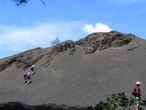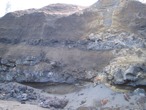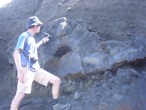Nanawale Littoral Cones
| Local Time |
Date |
Lat / Lon in Dec Degrees |
Elevation |
| 12:50:00L |
9/11/04 |
N19.922 |
W153.454 |
48 m |
Our third stop brought us to the Nanawale Littoral Cones, the only two
littoral cones that have developed on the coast of Kilauea during the last
200 years (Hazlett, field guide). The cones were formed during the 1840
eruption which originally started in the upper east rift zone of Kilauea
(see image REGIONAL MAP.JPG). The first flow lasted less than a day. Several
days later, the eruption renewed 15 miles to the east now in the lower east
rift zone of Kilauea, near Pahoa and lasted 26 days. Caused by
magma-seawater interactions a phreatomagmatic eruption is thought to have
formed the tephra hills when hot A'a lava coming from the W entered the sea
and was cooled rapidly.
The quenching of the flows caused an explosive reaction in which the lava
fragmented into tephra that settled as sandy hills on the coast, which
formed into mixed layers of tephra and lava flows (top left picture below).
Although a Pa'hoehoe flow makes up the basal unit of the stratigraphy, the
A'a flows are thought to be the source of the tephra layers due to the fact
that A'a lava has a larger portion of exposed surface area and therefore
tends to end up in explosive events. Especially the northern cone was the
location of the day's exercise. We studied the layers of the two sand hills
(top middle picture below) to determine what might have caused them and to
find out more about relationships between the several flows. By looking at
the number and the orientation of the layers (top right picture below), we
tried to reconstruct the different eruption cycles. Near the southern part
of the cone no lava flows were found and the largest thickness of the Pa'hoehoe base was determined. The far north end in contrast contained the
highest concentration of lava flows. The whole observation site is thought
to be an alternating sequence of lava and tephra layers (bottom left picture
below) The A'a flows are interpreted as flown sequencially into the wet
sediment and build up pillow-like structures within these. Their structures
sometimes appear with cavities in the center of the lava bodies (bottom
right picture below) which were caused by rapid cooling of the outer lava skin and
final degassing of the still liquid lava in the center.
Samples of different sites of the outcrop and originated in different
layers were taken and will be dried, sieved, and weighed. Along with that
data and the sizes of the ten largest grains in the samples, we will be able
to learn more about the distribution of grain size within the cone that will
help to reconstruct more details about the different events that took place.

North Nanawale littoral cone
Marcel Croon
|

Layered tephra deposit
Dayna Cordano
|

Layered stratigraphy of northern littoral Nanawale cone
Marcel Croon
|

Detail of stratigraphic layers of Nanawale littoral cone
Cara Johnson
|

Pillow-like structure of lava formed in wet sediment
Vincent Morton
|
|